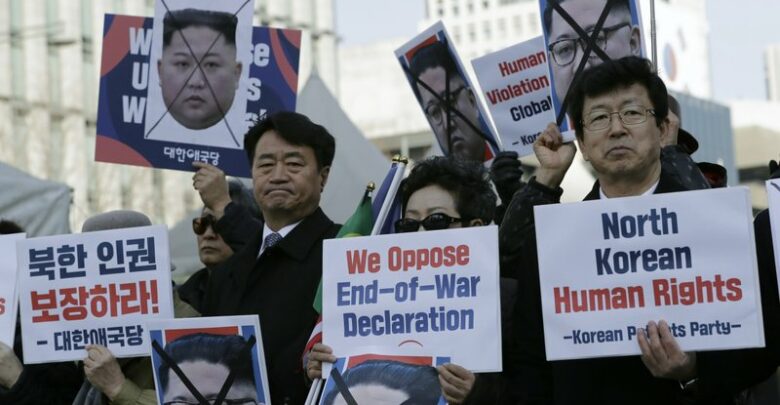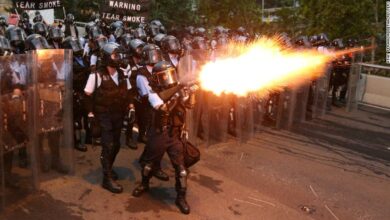Human rights group locates North Korean execution sites

SEOUL, South Korea (AP) — A human rights group said Tuesday it has identified hundreds of spots where witnesses claim North Korea carried out public executions and extrajudicial state killings as part of an arbitrary and aggressive use of the death penalty that is meant to intimidate its citizens.
The Seoul-based Transitional Justice Working Group said its research was based on interviews with 610 North Korean defectors conducted over four years who helped locate the sites with satellite imagery.
The group didn’t reveal the exact locations of the 323 sites because it’s worried that North Korea will tamper with them, but said 267 of them were located in two northeastern provinces near the border with China, the area where most of the defectors who participated in the study came from.
North Korea’s public executions tend to happen near rivers, in fields and on hills, and also at marketplaces and school grounds — places where residents and family members of those sentenced are often forced to attend the killings, the report said.
The group also said it documented three sites where people died while in detention and 25 sites where the dead were allegedly disposed of by the state. It said it also found official locations that may have documents or other evidence related to the killings.
The Associated Press could not independently verify the report, and the group acknowledged that its findings weren’t definite because it doesn’t have direct access to North Korea and cannot visit the sites defectors told it about. Ethan Hee-Seok Shin, one of the report’s authors, also said interviews with defectors suggest that public executions in North Korea are becoming less frequent, although it’s unclear whether that’s because more people are being executed in secret.
South Korea’s Korea Institute for National Unification, a state-sponsored think tank, expressed similar views on its annual white paper on North Korea’s human rights released last week. The institute said the North still uses public executions to provoke fear and control the behavior of its citizens, particularly in city and border areas where crimes are more prevalent.
The Transitional Justice Working Group is a nongovernment organization founded by human rights advocates and researchers from South Korea and four other countries. The group said the new report was made possible by funding from the Washington-based National Endowment for Democracy, which is funded by the U.S. Congress.
North Korea didn’t immediately respond to the report, but the nation bristles at outside criticism of its human rights record and claims negative assessments are part of U.S.-led pressure campaigns meant to tarnish the image of its leadership and destroy the country’s political system. In a report to the United Nations Human Rights Council in May, North Korea said it “consistently maintains the principle of ensuring scientific accuracy, objectivity and impartiality, as well as protecting human rights in dealing with criminal cases.”
A 2014 United Nations report on North Korea’s human rights conditions, however, said state authorities carry out executions, “with or without trial, publicly or secretly,” in response to political and other crimes that are often not among the most serious offenses. While public executions were more common in the 1990s, North Korea continues to carry them out for the purpose of instilling fear in the general population, the report said.
The new report said its findings show arbitrary executions and extrajudicial killings under state custody have continued under the rule of young leader Kim Jong Un despite international criticism over how North Korea supposedly applies the death penalty without due judicial process.
Since assuming leadership in 2011, Kim has shown a brutal side while consolidating his power, executing a slew of members of the North Korean old guard, including his uncle Jang Seong Thaek, who was convicted of treason, and senior officials accused of slighting his leadership.
Following a provocative run in nuclear and missile tests, Kim initiated diplomacy with Washington and Seoul in 2018 in attempting to leverage his arsenal for economic and security benefits. But North Korea’s human rights issues have so far been sidelined in the summitry between Kim, President Donald Trump, and South Korean President Moon Jae-in.
Almost all of the state killings documented in the report were public executions by firing squad. Public executions in most cases are preceded by brief “trials” on the spot where charges are announced and sentences are issued without legal counsel for the accused, the report said.
Criminal charges for executions commonly cited by interviewees included violent crimes such as murder, rape and assault, but also property crimes like stealing copper or cows and brokering defections. With a lack of due process in the North’s judicial system, it’s unclear whether the charges would actually match the act of the accused, the report said.
Bodies of people killed by state agents aren’t usually returned to the family and are often dumped in mountainous areas, buried in the ground without markers, or thrown into a gorge or ravine, the report said.
Authorities often force family members of those sentenced and residents, including children, to watch public executions. Some defectors reported incidents in the mid-2010s where guards used metal detectors to find and confiscate mobile phones from witnesses to prevent them from recording the events, which showed the government’s concern about information on the public executions getting outside the country, the report said.
The rights group said the information it gathered will be crucial if a political transition in North Korea allows for the identification of victims, the return of remains to families and investigations into human rights abuses committed by the government.
The group released an earlier report in 2017 based on a smaller number of interviews. It said the new report is better sourced, based on accounts of direct witnesses or those who heard from direct witnesses and were able to provide geographic information of the sites.

